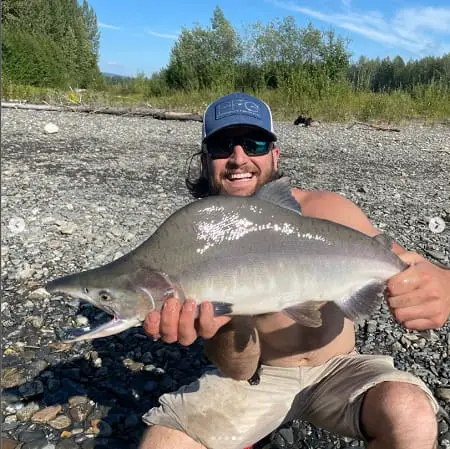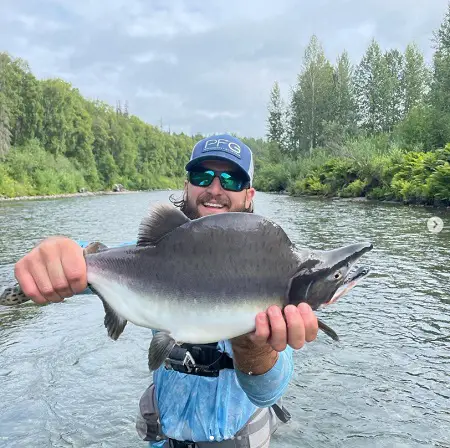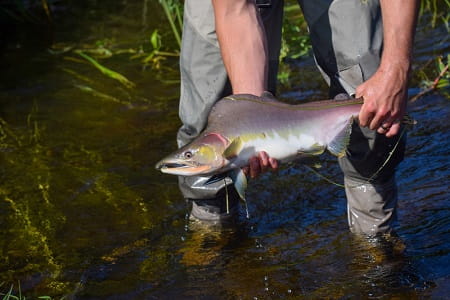Proven Pink Salmon Fishing Tactics That Work!

Although small, many fishermen love pink salmon fishing, but you need to know when to go. Pinks only return to rivers on odd-numbered years, but they return in huge numbers, and they are also fun to fish out in the open ocean.
In this article, I’ll discuss guide-proven tactics, the best baits, and the information you need to know for successful pink salmon fishing in rivers and out in the ocean.
Let’s explore the when, where, and how to catch pink salmon.
Understanding Pink Salmon

Pink salmon, also known as humpback salmon, are prevalent in various regions, from the Pacific Northwest Ocean to the streams and rivers stretching from Alaska down to central California.
The pink salmon is the smallest of the five Pacific salmon species.
An adult pink salmon typically weighs in at 3 to 5 pounds, and they are often referred to as “humpies” due to the pronounced hump that forms on the male pinks backs during spawning.
Dietary Habits of Pink Salmon
While in the ocean, pink salmon have a diverse diet, feasting on small fish, crustations, zooplankton, and small squid.
Once they enter the river, they will feed on small baitfish, salmon eggs, insects, worms, and anything that appears edible.
The Spawning Season
Pink salmon, like their fellow Pacific salmon species, follow an anadromous life cycle but with two unique characteristics. First, they only return on odd-numbered years, and second, they have a short life span of 2 years. Ultimately, they return to their natal rivers to spawn from late July to late October to complete their life cycle.
In most areas, the peak season runs are from mid-August to October, and they are eager to bite once they’re in the river.
River Fishing for Pink Salmon
Fishing for pink salmon in rivers differs significantly from the ocean experience.
Strategic River Locations for Pink Salmon

Pink salmon are known to traverse extensive stretches of river, so it’s essential to adapt your fishing approach to the river’s conditions. Here, we divide the river into three sections and discuss how to optimize your chances of catching pink salmon.
- Lower River:
- On very large rivers like the Fraser River, anglers utilize trolling techniques, or shore and bank anglers focus on deep edges and narrows that funnel the pink salmon as they move upriver. Pink salmon activity often peaks 2 hours prior to, during high tides, and a couple of hours after high tides.
- On smaller rivers, the lower reaches can resemble trout streams, allowing fishermen to employ traditional fishing methods. Fly fishing and casting lures, or float fishing, are the predominant methods.
- Travel Routes:
- As pink salmon journey upstream, they rely on currents and riverbed depths to navigate. They usually swim nose-first into the current and they will follow the deeper side of the river, which serves as a travel route. In fast and turbid waters, they may venture closer to the shore.
- Keep an eye out for seams and bubble lines, as these often indicate travel routes. Avoid areas with back eddies and turbulent waters.
- Holding Water:
- The best spots to fish for pink salmon are those with slow, deep water. Look for deeper pools, pockets, and locations below rapids, where salmon can conserve energy and are more likely to strike.
Methods for River Fishing
Various fishing methods can be used to for targeting pink salmon effectively during pink salmon season:
- Fly Fishing:
- Fly fishing is very effective and enjoyable for pink salmon. Fly fishers should consider using streamer flies that mimic baitfish or nymphs resembling bugs or salmon eggs. Pink flies are best to catch pinks. A 5 to 7 weight fly rod is suitable for even the largest pink salmon.
- Float Fishing:
- Float fishing involves presenting bait below a bobber or river float and drifting the rig downstream with the current. A longer rod is advantageous for this method.
- Drift Fishing:
- Drift fishing methods offer an effective means of presenting bait without using a float.
- Casting Lures:
- Casting small lures from the riverbank covers a significant amount of water and can be fruitful for pink salmon, as well as other salmon species like chinook salmon. Casting lures is particularly effective in frog water. Twitching jigs also proves successful for river pink salmon.
- Plunking for Salmon:
- Plunking is a stationary fishing technique where you cast a heavy weight to anchor your bait or lure near the riverbed while waiting for passing pink salmon.
- Side Drifting:
- Side drifting involves drifting down the river in a boat while presenting bait beside the boat. This method allows for extended drifts and wide coverage of water.
- Back Trolling:
- Back trolling is another highly effective technique, especially when using lures. It entails running multiple lures from the back of a boat and slowly drifting towards the pink salmon.
Be prepared for the possibility of hooking coho salmon, chum salmon, or king salmon.
Essential Gear for River Fishing
Pink salmon are smaller, so lighter gear is suitable, however, they may be small, but they are hard-fighting acrobatic fish.
- Rods:
- The choice of fishing rod depends on your preferred fishing method. For example, an light to medium-light 8-foot fast action rod is ideal for twitching jigs, while an 11 to 14-foot float rod suits float fishing. For back trolling, a rod with a softer rod tip is preferable. Most medium light rods with a line rating of 6 to 12 will do for pink salmon.
- Reels:
- Spinning reels are commonly used by many anglers, although baitcasting reels are suitable for most methods and excel in boat fishing.
- Line:
- Select your line based on your chosen fishing method. Generally, an 8 to 12-pound line is a good choice for fishing pinks.
Top Lures and Baits for River Fishing
A few tried-and-true lures and baits consistently attract pink salmon in river settings:
Best Fishing Lures:
- Spoons, spinners, plugs, and jigs ranging in size from 1 to 3 inches. Pinks, love the color pink, however, various colors are all effective choices. Erratic and brightly colored lures tend to provoke strikes. Dark or black lures can also be successful. Here are some top options:
- Blue Fox Vibrax in sizes 3 and 4 (replace treble hooks with a single siwash hook).
- Dick Nite Spoons.
- Twitching jigs, such as the Aerojig Rabbit Salmon Twitching Jig.
- Little Cloe.
- Brads Wiggler.
- Yakima Bait Mag Lip.
- Mini Sardine Squid
Best Baits
- Boost your chances with the right bait. Options include chunks of skein, salmon eggs in a sack known as a roe bag or spawn sac, prawns, flies, worms, and artificial baits like beads.
Pink Salmon Fishing in the Ocean
For many anglers, venturing into open waters offers good fishing for pinks.
Prime Ocean Locations for Pink Salmon
During the summer, pink salmon can often be found far from the shoreline. They tend to gather in tide rips, areas where surface currents converge, and deep underwater structures rich in baitfish like herring.
On overcast days and early morning, pink salmon may swim closer to the surface, even in depths exceeding 200 feet. Typically, most pink salmon are caught at depths ranging from 10 to 100 feet.
As late summer approaches, pink salmon move closer to beaches and shorelines as they prepare for their journey to their chosen spawning rivers. Moving in closer to rivers in early September.
Optimal Methods for Ocean Fishing
Ocean fishing for pink salmon offers several effective approaches to catch fish:
- Trolling for Salmon:
- Trolling involves using deep-diving lures, heavy weights, downriggers, or divers to reach the desired depth where the salmon are located.
- Trolling Speed:
- Most fishermen recommend trolling between 1 to and 2.5 mph for pink salmon.
- Trolling Tackle:
- Trolling with a flasher and hoochie, plastic squid, or a spoon is a prevalent method on charter boats. Achieving a fast rotation of the flasher is essential. When using cut-bait herring, make sure it spins rapidly.
- Jigging for Salmon:
- Jigging over the side of the boat is another method favored by pink salmon anglers.
- Beach Fishing for Salmon:
- Anglers without boats often capitalize on higher tides that push pink salmon closer to the shore where they can beach fish for salmon. Pink salmon come closer to shore when they seek out their preferred spawning river. Casting pink lures or jigs is a popular choice for beach anglers looking to catch pink salmon.
Essential Gear for Ocean Pink Fishing
Ensure you have the right equipment for ocean fishing. Light gear is suitable for ocean fishing:
- Rods:
- Long trolling rods ranging from 9 to 11 feet are preferred by boat anglers. Choose rods designed for your specific fishing method, whether that be downriggers, dipsy rods, or trolling rods.
- Reels:
- To accurately measure the line you have out, consider using line counter baitcasting reels. This allows you to adjust the line length to reach your desired depth efficiently.
- Line:
- Anglers frequently use monofilament lines, lead-core lines, copper lines, and braided line, with line strengths ranging from 40 to 65 pounds.
- Net and Release Gear:
- Invest in a good salmon net with a wide-hoop net with a long handle and a deep net bag. Don’t forget to have gloves and long pliers on hand for safe handling.
Top Lures and Baits for Ocean Fishing
Pink salmon are partial to trolling spoons, hoochies, trolling flies, and cut bait rigs.
Harvesting Tips for Pink Salmon
Properly harvesting and storing your freshly caught pink salmon can significantly impact the taste when it hits your dinner table. Here are some charter boat secrets for harvesting pink salmon:
- Dispatch Swiftly:
- Quickly stun or kill your freshly caught pink salmon with a couple of firm blows to the top of the head.
- Bleed the Salmon:
- Cut or rip the gills on both sides to bleed the salmon. This step is crucial for enhancing the salmon’s flavor.
- Air Time:
- Place the pink salmon head down in a bucket or suspend it from a stringer for about 5 minutes.
- Keep It Cool:
- Place the salmon on ice as soon as possible. If you’re fishing from the bank, string the salmon on a stringer and keep it in the water until you’re ready to depart. Then, get it onto ice without delay.
7 Expert Tips for Catching Pink Salmon
To catch pink salmon consistantly, consider these seven expert tips:
- Rotate Colors:
- Experiment with different lure colors, however, always start with pink. Bright chartreuse may work wonders on sunny days, while copper or gold may be preferred on cloudy days. Silver and bright colors can also be effective. Don’t hesitate to switch between colors to match the fish’s preferences.
- Rotate Baits:
- Some days, pinks may favor straight-moving spinners, while on others, wobbling plugs or a small pink jig might prove more enticing.
- Vary the Size:
- Keep a selection of lure sizes on hand to adapt to river conditions and the salmon’s mood. Larger lures and bait are suitable for murky water or low-light conditions, while smaller spoons, crankbaits, and plugs work well in clear water or when salmon are holding in one spot.
- Cover the Water Thoroughly:
- Many anglers tend to overlook the importance of thoroughly covering the water. To catch more fish, ensure your lure reaches all areas of the fishing zone and water column.
- Fish the Right Water:
- Pink salmon occupy different types of water during their migration. In low, clear water, especially during sunny days, they tend to favor deeper pools. During early morning hours, evenings, and early autumn, pink salmon may move to the head of pools, pocket water, and runs. Later in the fall, they migrate further upstream in search of spawning locations, leaving the lower river relatively empty. Follow the salmon’s migration to find success.
- High-Water Fishing:
- In larger rivers, pink salmon can enter at any time due to the higher flow and depth. However, they often make their move during high tide. In smaller, lower rivers, pink salmon wait for significant rainfall to raise water levels before entering. They will also start their runs in the dark or early morning hours. Take advantage of these conditions for optimal fishing opportunities.
- Watch for Surface Activity:
- Both in the ocean and rivers, keep an eye out for surface activity, such as jumping, rolling, or boiling pinks. These behaviors can help you locate active fish.
Some Places To Consider
- Puget Sound Pink Salmon: Puget Sound and South Puget sound are hotspots. Fish first light, high tides, and the evening bite.
- Point Wilson at Fort Worden State Park in Port Townsend
- Richmond beach
- Strait of juan de fuca
- West Point in Seattle
- Picnic Point
- Fraser River
- Harrison river – A tributary of the Fraser River.
- Chilliwack River / Vedder River
Pink Salmon Fishing Q&A
If you have questions, comments, or tips to share about pink salmon fishing, feel free to join the discussion in the comments section below.
Tight lines,
Graham
